Analyses of Runoff and Sediment Transport and their Drivers in a Rare Earth Mine Drainage Basin of the Yangtze River, China
Abstract
:1. Introduction
2. Overview of Study Area
3. Data and Main Methodology
3.1. Data
3.2. Analytical Methods
3.2.1. Cross-Wavelet Transform
3.2.2. Wavelet Transform Coherence (WTC)
4. Results and Discussion
4.1. Runoff and Sediment Transport
4.1.1. Inter-Annual Variation
4.1.2. Annual Variation
4.1.3. Mutation Analysis
4.1.4. Periodic Variation
4.2. Driving Factors of Runoff and Sediment Transport
4.2.1. Precipitation
Cross-Wavelet Analysis of Precipitation, Runoff, and Sediment Transport
Quantitative Analysis of the Influence of Precipitation on Runoff and Sediment Transport
4.2.2. Water Conservancy Projects
4.2.3. ENSO
5. Conclusions
- A mutation occurred in the sediment transport rate in 2005 and a significant decline was observed as well. However, no significant change was found in the runoff volume from 1957 to 2015. From the year 2005 onwards, the annual average decrease of sediment transport volume was 8.82 × 107 tons;
- The precipitation was the dominant factor that controlled the changes in runoff volume and sediment transport volume, since the precipitation directly influenced changes of the runoff volume, which subsequently caused changes in the sediment transport rate in the river basin. From the year 2005 onwards, changes in the sediment transport rate were heavily influenced by the large-scale hydro-power stations (Taojiang and Julongtan), with a significant declining trend observed. The annual sediment transport decreased by 8.44 × 107 tons during 1980–2004 and 2005–2015, accounting for 95.7% of the total decrease in the sediment transport volume;
- Significant resonance cycles between SST and the precipitation, runoff volume, and sediment transport mainly covered the 1.33–5.33a-year period. During the ENSO events, the precipitation, runoff volume, and sediment transport rate reached their maximums after a decline at the beginning of each event, and then eventually decreased again.
Author Contributions
Funding
Acknowledgments
Conflicts of Interest
References
- Lal, R. Soil degradation by erosion. Land Degrad. Dev. 2001, 12, 519–539. [Google Scholar] [CrossRef]
- Morgan, R.P.C. Soil Erosion and Conservation, 3rd ed.; Blackwell Publishing: Oxford, UK, 2009. [Google Scholar]
- Cerdan, O.; Govers, G.; Le Bissonnais, Y.; Van Oost, K.; Poesen, J.; Saby, N.; Gobin, A.; Vacca, A.; Quinton, K.; Auerswald, K.; et al. Rates and spatial variations of soil erosion in Europe: A study based on erosion plot data. Geomorphology 2010, 122, 167–177. [Google Scholar] [CrossRef]
- Carroll, C.; Merton, L.; Burger, P. Impact of vegetative cover and slope on runoff, erosion, and water quality for field plots on a range of soil and spoil materials on central Queensland coal mines. Soil Res. 2000, 38, 313–328. [Google Scholar] [CrossRef]
- Wantzen, K.M.; Mol, J.H. Soil erosion from agriculture and mining: A threat to tropical stream ecosystems. Agriculture 2013, 3, 660–683. [Google Scholar] [CrossRef] [Green Version]
- Martín-Moreno, C.; Martín Duque, J.F.; Nicolau Ibarra, J.M.; Hernando Rodríguez, N.; Sanz Santos, M.Á.; Sánchez Castillo, L. Effects of topography and surface soil cover on erosion for mining reclamation: The experimental spoil heap at El Machorro Mine (Central Spain). Land Degrad. Dev. 2016, 27, 145–159. [Google Scholar] [CrossRef] [Green Version]
- Wang, P.; Liu, S.F. Status of soil erosion of south China rare-earth mining area. Soil Water Conserv. China 2008, 3, 44–46. [Google Scholar]
- Zheng, T.; Yang, J.; Huang, P.; Tang, C.; Wan, J. Comparison of trace element pollution, sequential extraction, and risk level in different depths of tailings with different accumulation age from a rare earth mine in Jiangxi Province, China. J. Soil Sediment 2018, 18, 992–1002. [Google Scholar] [CrossRef]
- Wen, X.J.; Zhang, D.C. Effect of resource exploitation on soil environment and rare earth bioavailable fractions in plough layer of mining area. China Min. Mag. 2012, 21, 44–47. [Google Scholar]
- Yang, X.J.; Lin, A.; Li, X.L.; Wu, Y.; Zhou, W.; Chen, Z. China’s ion-adsorption rare earth resources, mining consequences and preservation. Environ. Dev. 2013, 8, 131–136. [Google Scholar] [CrossRef]
- Li, Y.X.; Zhang, L.; Zhou, X.M. Resource and environment protected exploitation model for ion-type rare earth deposit in southern of China. Chin. Rare Earths 2010, 31, 80–85. [Google Scholar]
- Liu, Y.; Liu, Z.; Liu, J.; Chen, M.; Zhang, J.; Xu, Y.; Liu, M. Distribution characteristics and risk assessment of ammonia nitrogen and heavy metal pollution in longjing river, the upstream of ganjiang river. Nonferr. Met. Sci. Eng. 2019, 10, 85–93. [Google Scholar]
- Liao, Z.; He, W.; Liu, H.; Wang, X. Quality assessment of geological environment of ion-absorbed rare-earth mine in Longnan County. Nonferr. Met. Sci. Eng. 2014, 5, 106–111. [Google Scholar]
- Liu, S.W.; Liu, X.D.; Tan, K.Y.; Huang, Y.Y. Characteristics of soil pollution caused by mining in ion-absorbed rare earth mines and crucial issues of the polluted soil restoration: A case study of longnan rare earth mines, south china. Adv. Mater. Res. 2014, 955–959, 2564–2569. [Google Scholar] [CrossRef]
- Zou, G.; Wu, Y.; Cai, S. Impacts of ion-adsorption rare earth’s leaching process on resources and environment. Nonferr. Met. Sci. Eng. 2014, 5, 100–106. [Google Scholar]
- Sarachik, E.S.; Cane, M.A. The El Nino-southern Oscillation Phenomenon; Cambridge University Press: Cambridge, UK, 2010. [Google Scholar]
- Liu, Y.; Lu, M.; Huo, X.; Hao, Y.; Gao, H.; Cui, Y.; Metivier, F. A Bayesian analysis of generalized pareto distribution of runoff minima. Hydroll. Process. 2016, 30, 424–432. [Google Scholar] [CrossRef]
- Mann, H.B. Non-parametrictests against trend. Econometrica, 1945; 13, 163–171. [Google Scholar]
- Kendall, M.G. Rank Correlation Methods, 4th ed.; Charles Griffin: London, UK, 1975. [Google Scholar]
- Liu, Y.; Liu, Y.; Chen, M.; Labat, D.; Li, Y.; Bian, X.; Ding, Q. Characteristics and drivers of reference evapotranspiration in hilly regions in southern China. Water 2019, 11, 1914. [Google Scholar] [CrossRef] [Green Version]
- Wang, F.; Shao, W.; Yu, H.; Kan, G.; He, X.; Zhang, D.; Ren, M.; Wang, G. Re-evaluation of the power of the Mann-Kendall test for detecting monotonic trends in hydrometeorological time series. Front. Earth Sci. 2020. [Google Scholar] [CrossRef]
- Grinsted, A.; Moore, J.C.; Jevrejeva, S. Application of the cross wavelet transform and wavelet coherence to geophysical time series. Nonlinear Proc. Geophys. 2004, 11, 561–566. [Google Scholar] [CrossRef]
- Ding, Q.; Liu, Y.; Jiao, K.; Bian, X.; Liu, Y. Changes and driving factors of runoff and sediment yield of typical watershed in upper reaches of Ganjiang River. Bull. Soil Water Conserv. 2018, 38, 19–26, 33. [Google Scholar]
- Zhao, Z.H. Study on Non-point Pollution in Tao River Basin’s Agricultural Field Based on AnnAGNPS Model. Jiangxi: Nanchang Univ. 2012. [Google Scholar] [CrossRef]
- Yamasaki, K.; Gozolchiani, A.; Havlin, S. Climate networks around the globe are significantly affected by El Nino. Phys. Rev. Lett. 2008, 100, 228501. [Google Scholar] [CrossRef]
- Collins, M.; An, S.I.; Cai, W.; Ganachaud, A.; Guilyardi, E.; Jin, F.F. The impact of global warming on the tropical Pacific Ocean and El Niño. Nat. Geosci. 2010, 3, 391–397. [Google Scholar] [CrossRef]
- Adamowski, J.F. River flow forecasting using wavelet and cross-wavelet transform models. Hydrol. Process. An Int. J. 2008, 22, 4877–4891. [Google Scholar] [CrossRef]
- Labat, D. Cross wavelet analyses of annual continental freshwater discharge and selected climate indices. J. Hydrol. 2010, 385, 269–278. [Google Scholar] [CrossRef]
- Labat, D.; Ababou, R.; Mangin, A. Wavelet analysis in karstic hydrology. 2nd part: Rainfall-runoff cross-wavelet analysis. Comptes rendus de l’Academie des Sciences. Serie 2. Fascicule a. Sciences de la terre et des planetes/Earth and planetary sciences. Montrouge 1999, 329, 881–887. [Google Scholar]
- Yu, H.L.; Lin, Y.C. Analysis of space–time non-stationary patterns of rainfall–groundwater interactions by integrating empirical orthogonal function and cross wavelet transform methods. J. Hydrol. 2015, 525, 585–597. [Google Scholar] [CrossRef]
- Fekete, B.M.; Vörösmarty, C.J.; Roads, J.O.; Willmott, C.J. Uncertainties in precipitation and their impacts on runoff estimates. J. Climate 2004, 17, 294–304. [Google Scholar] [CrossRef]
- Xu, K.; Milliman, J.D.; Xu, H. Temporal trend of precipitation and runoff in major Chinese rivers since 1951. Glob. Planet Chang. 2010, 73, 219–232. [Google Scholar] [CrossRef]
- Liu, Y.; Wu, J.; Liu, Y.; Hu, B.X.; Hao, Y.; Yeh, T.J.; Wang, Z.L. Analyzing effects of climate change on streamflow in a glacier mountain catchment using an ARMA model. Quatern. Int. 2015, 358, 137–145. [Google Scholar] [CrossRef]
- Ren, L.; Wang, M.; Li, C.; Zhang, W. Impacts of human activity on river runoff in the northern area of China. J. Hydrol. 2002, 261, 204–217. [Google Scholar] [CrossRef]
- Liu, Y.; Métivier, F.; Gaillardet, J.; Ye, B.; Meunier, P.; Narteau, C.; Lajeunesse, E.; Han, T.; Malverti, L. Erosion rates deduced from seasonal mass balance along the upper Urumqi River in Tianshan. Solid Earth 2011, 2, 283–301. [Google Scholar] [CrossRef] [Green Version]

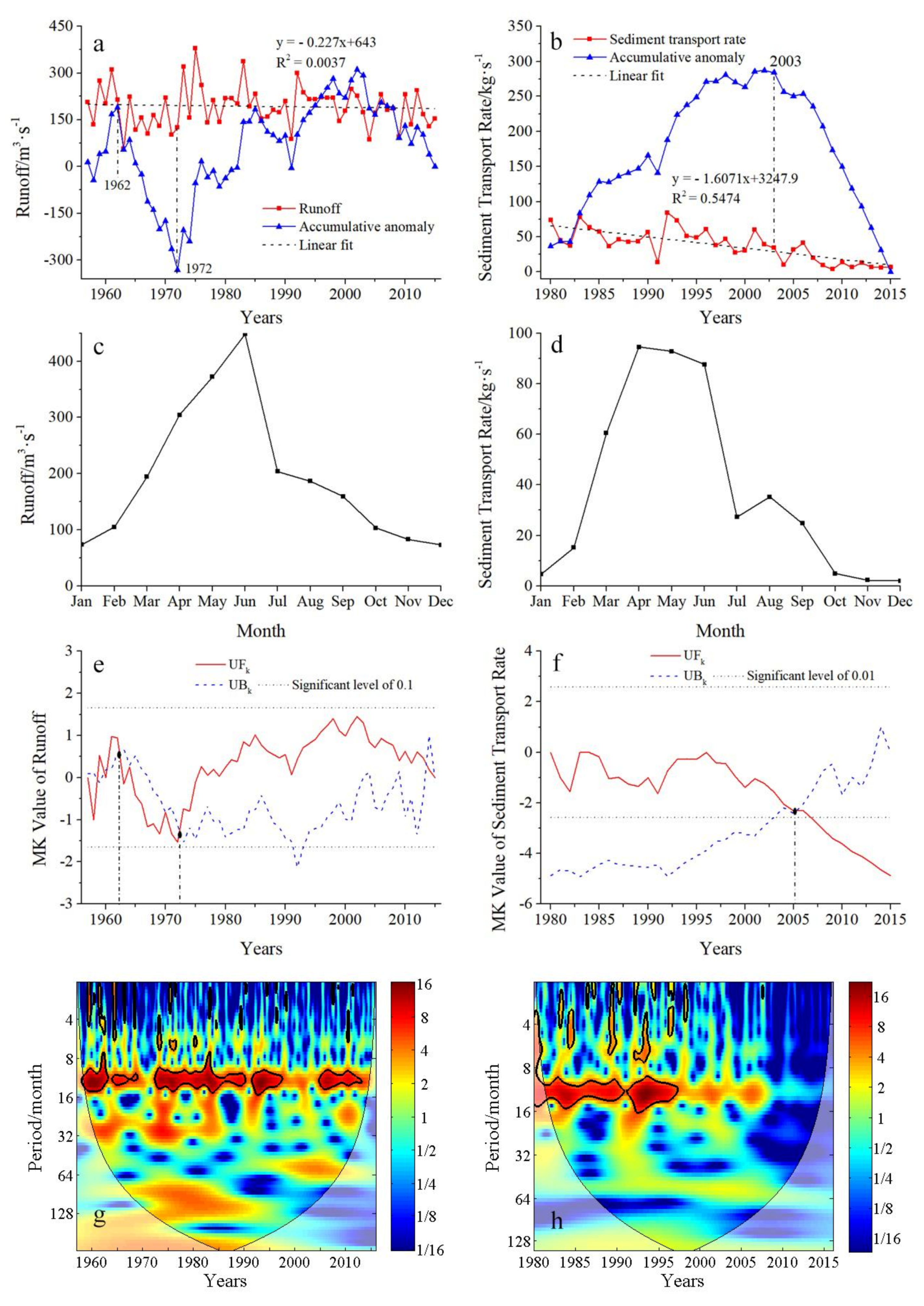

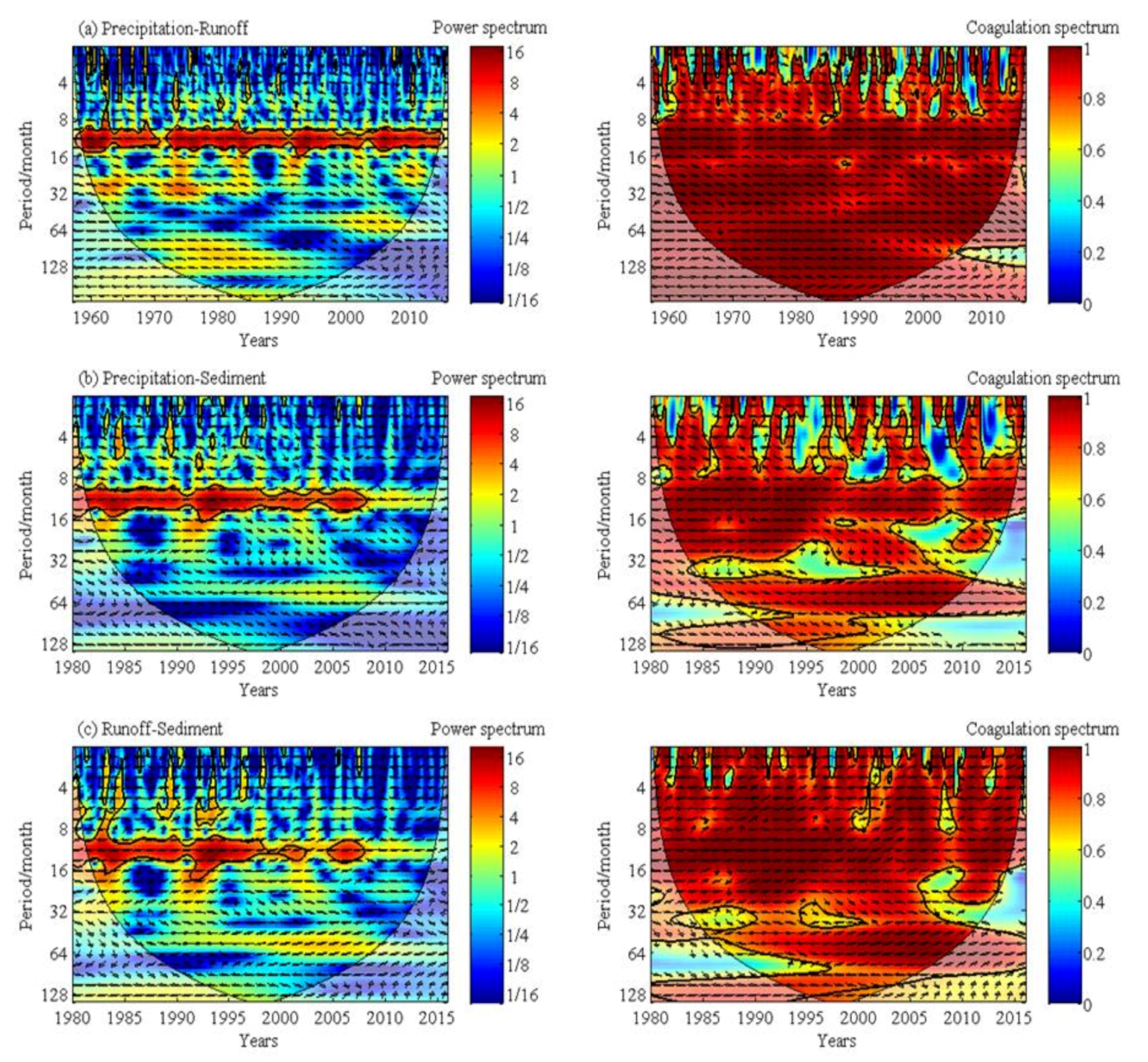
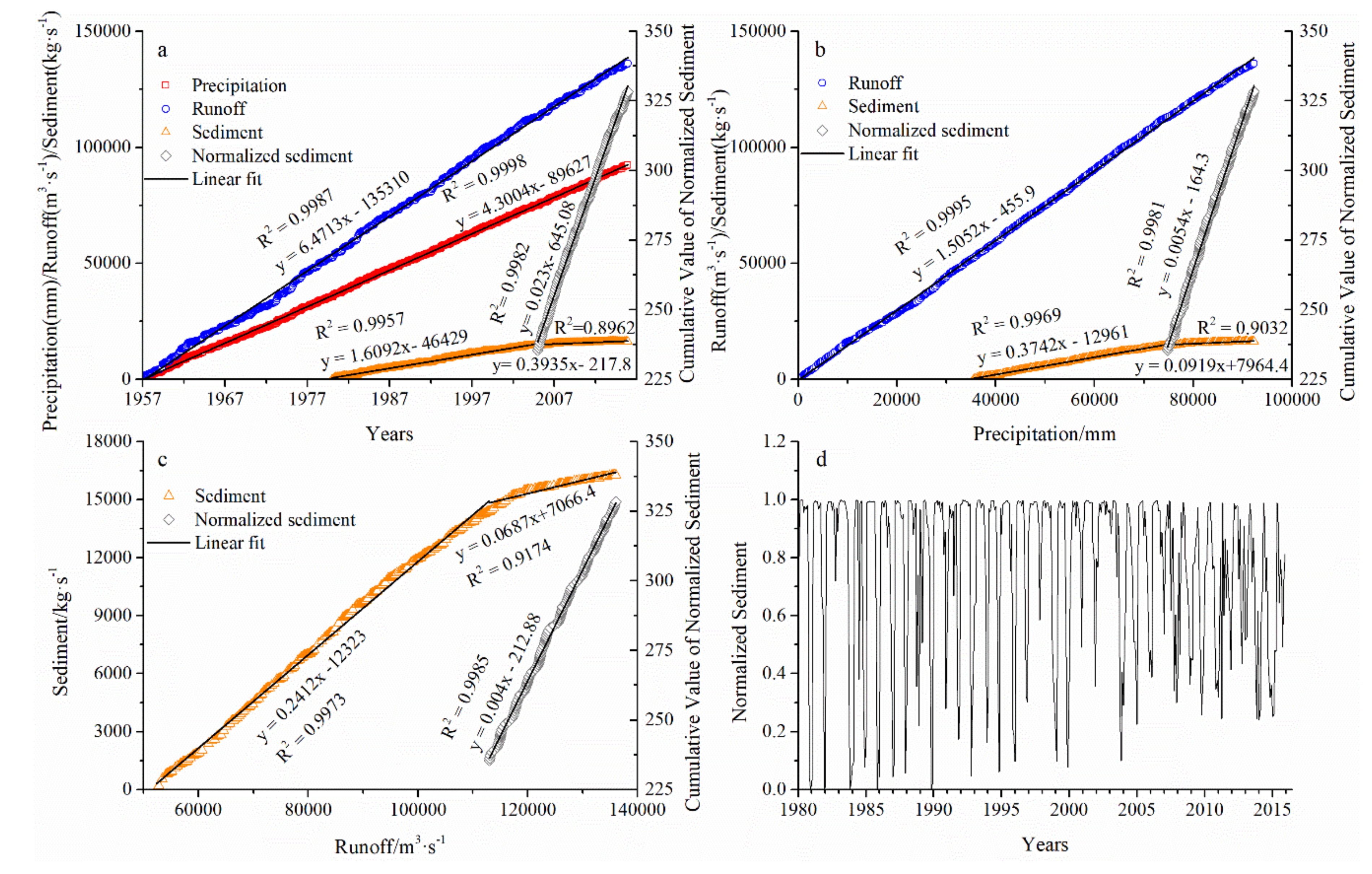
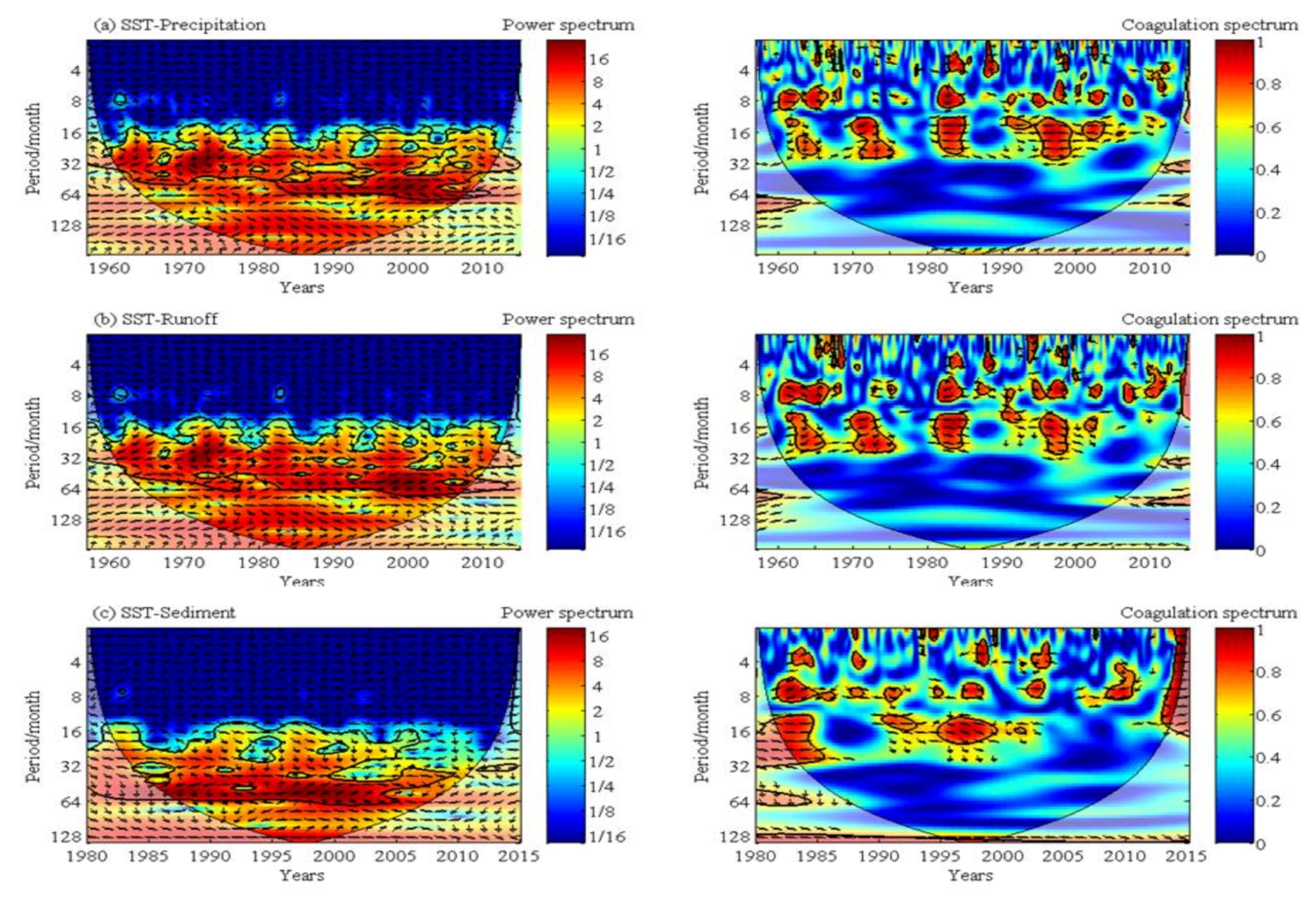
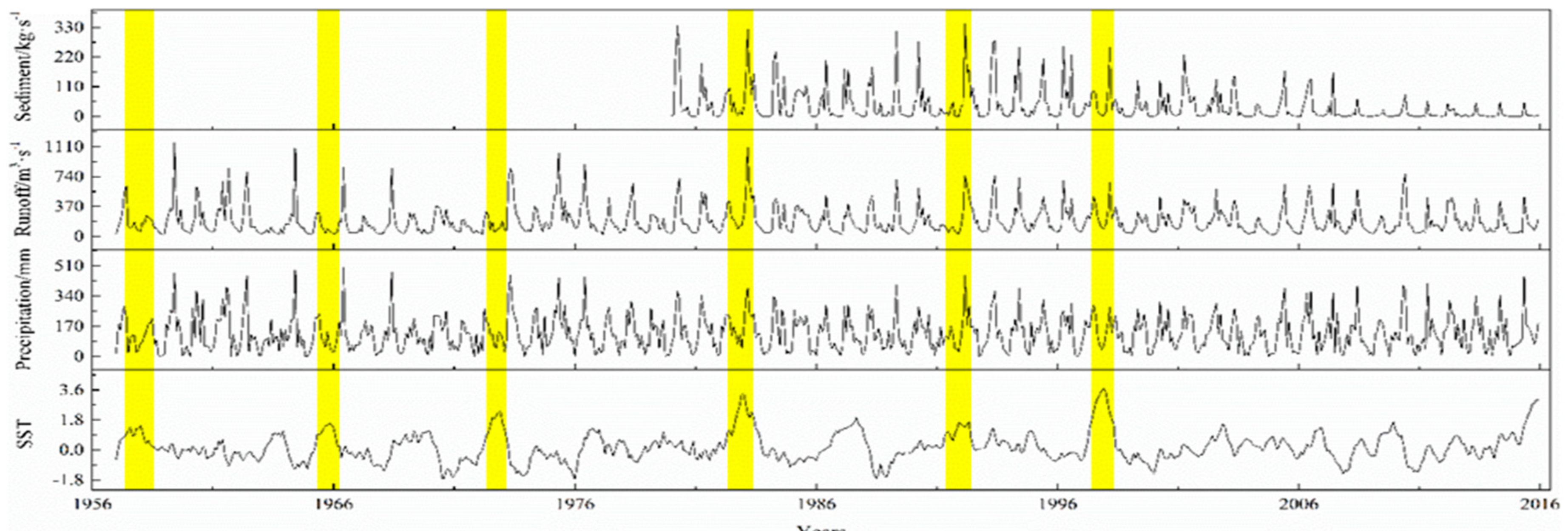
| Data Type | Station | Longitude | Latitude | Time Period |
|---|---|---|---|---|
| Runoff | Julongtan | 115°07′ E | 25°49′ N | 1957–2015 |
| Sediment | Julongtan | 115°07′ E | 25°49′ N | 1980–2015 |
| SST | 160°W–90° W | 5°N–5° S | 1957–2015 | |
| Precipitation | Shanggankeng | 114°19′ E | 24°43′ N | 1980–2015 |
| Gupi | 115°06′ E | 25°20′ N | 1965–2015 | |
| Jinpenshan | 115°12′ E | 25°16′ N | 1962–2015 | |
| Xintian | 115°15′ E | 25°22′ N | 1965–2015 | |
| Pitou | 114°35′ E | 25°01′ N | 1977–2015 | |
| Longyuanba | 114°27′ E | 24°56′ N | 1964–2015 | |
| Yuezi | 115°18′ E | 24°40′ N | 1963–2015 | |
| Luokeng | 114°19′ E | 24°37′ N | 1984–2015 | |
| Makenggang | 114°24′ E | 24°37′ N | 1980–2015 | |
| Dutou | 114°38′ E | 24°47′ N | 1958–2015 | |
| Guankeng | 114°40′ E | 24°39′ N | 1981–2015 | |
| Henggang | 114°42′ E | 24°36′ N | 1977–2015 | |
| Jiahu | 114°39′ E | 24°44′ N | 1964–2015 | |
| Shangwei | 114°30′ E | 24°35′ N | 1980–2015 | |
| Shuangluo | 114°36′ E | 24°43′ N | 1980–2015 | |
| Yangcun | 114°38′ E | 24°39′ N | 1980–2015 | |
| Chayuan | 114°58′ E | 25°24′ N | 2001–2015 | |
| Dajishan | 114°22′ E | 24°37′ N | 1962–2015 | |
| Hengxi | 115°01′ E | 25°35′ N | 1962–2015 | |
| Huangpodi | 115°12′ E | 25°38′ N | 1965–2015 | |
| Julongtan | 115°07′ E | 25°49′ N | 1957–2015 | |
| Nanjing | 114°23′ E | 24°41′ N | 1977–2015 | |
| Xinfeng | 114°56′ E | 25°23′ N | 1957–2015 | |
| Yangfang | 114°14′ E | 24°41′ N | 1980–2015 | |
| Zhushanxia | 114°18′ E | 24°40′ N | 1980–2015 | |
| Wenlong | 114°54′ E | 24°46′ N | 1963–2015 | |
| Youshan | 114°42′ E | 25°25′ N | 1962–2015 |
| Years | Decrease in the Sediment Transport/(104 t/year) | Decrease in the Sediment Transport Caused by the Runoff Volume (104 t/year) | |
|---|---|---|---|
| Human Activities | Total Decrease | ||
| 2005–2015 | 8440.79 | 8822.37 | 6817.99 |
| Water Conservancy Project | River System | DrainageArea/km2 | Total Storage Capacity/104 m3 | Year of Completion | Reinforcement Time |
| Zoumalong reservoir | Xihe River | 91.6 | 2 370 | 1958 | |
| Bailan reservoir | Anxi River | 24.4 | 1 160 | 1960 | 1998–2000 |
| Wudugang reservoir | Xiaohe River | 120 | 3 330 | 1961 | 2004/05–2005/07 |
| Shangjing reservoir | Anxi River | 31.6 | 1 185 | 1967 | |
| Longjing reservoir | Donghe River | 140 | 1 385 | 1969 | |
| Zhongcun reservoir | Xihe River | 29.2 | 1 092 | 1976 | |
| Longtoutan hydro-power station | Taojiang River | 2 653 | 1 380 | 2000 | |
| Taojiang hydro-power station | Taojiang River | 3 679 | 3 710 | 2004 | |
| Julongtan hydro-power station | Taojiang River | 7 739 | 7 760 | 2007 |
© 2020 by the authors. Licensee MDPI, Basel, Switzerland. This article is an open access article distributed under the terms and conditions of the Creative Commons Attribution (CC BY) license (http://creativecommons.org/licenses/by/4.0/).
Share and Cite
Liu, Y.; Ding, Q.; Chen, M.; Zhong, L.; Labat, D.; Zhang, M.; Mao, Y.; Li, Y. Analyses of Runoff and Sediment Transport and their Drivers in a Rare Earth Mine Drainage Basin of the Yangtze River, China. Water 2020, 12, 2283. https://doi.org/10.3390/w12082283
Liu Y, Ding Q, Chen M, Zhong L, Labat D, Zhang M, Mao Y, Li Y. Analyses of Runoff and Sediment Transport and their Drivers in a Rare Earth Mine Drainage Basin of the Yangtze River, China. Water. 2020; 12(8):2283. https://doi.org/10.3390/w12082283
Chicago/Turabian StyleLiu, Youcun, Qianqian Ding, Ming Chen, Lirong Zhong, David Labat, Ming Zhang, Yimin Mao, and Yongtao Li. 2020. "Analyses of Runoff and Sediment Transport and their Drivers in a Rare Earth Mine Drainage Basin of the Yangtze River, China" Water 12, no. 8: 2283. https://doi.org/10.3390/w12082283
APA StyleLiu, Y., Ding, Q., Chen, M., Zhong, L., Labat, D., Zhang, M., Mao, Y., & Li, Y. (2020). Analyses of Runoff and Sediment Transport and their Drivers in a Rare Earth Mine Drainage Basin of the Yangtze River, China. Water, 12(8), 2283. https://doi.org/10.3390/w12082283







